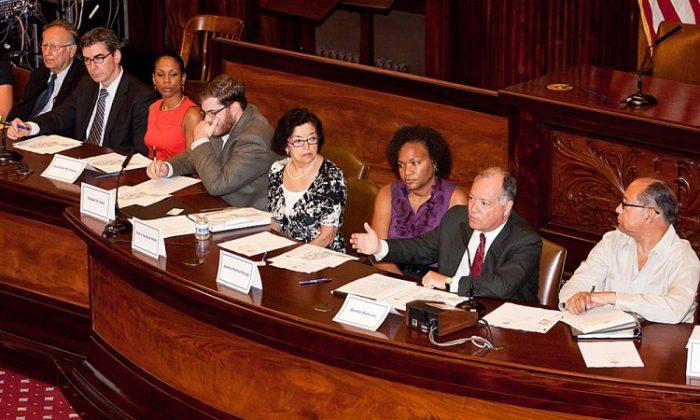NEW YORK—The city’s Districting Commission released its preliminary redrawn map, adjusted based on population changes within the five boroughs, using information from the 2000 and 2010 censuses.
Redistricting, which happens every decade, can impact New Yorkers quite profoundly, according to the Brennan Center for Justice at NYU’s School of Law.
“The way the lines are drawn can keep a community together or split it apart, leaving it without a representative who feels responsible for its concerns,” it states on its website. “The way the lines are drawn can change who wins an election. Ultimately, the way the lines are drawn can change who controls the city and what laws get passed.”
The mayor appoints seven persons to the Districting Commission and the City Council appoints eight. The city’s redistricting is generally believed fairer than the partisan struggle that mars redistricting in New York state.
After public hearings in each of the five boroughs, the commission produced the preliminary map Wednesday; after another round of public hearings it will produce a potentially final version by Nov. 5.
The City Council could object to that version, though, according to commission general counsel Thaddeus Hackworth, which would trigger a third set of meetings and a third and definitive version of the map, which the council could not block. In the last round of the districting process, City Council submitted objections, according to Hackworth.
Population Changes and Cultural Growth
In the preliminary version of the district map, no extra City Council members were added. But population changes—in the boroughs and culturally—in the 10 years between the censuses have propelled the need for shifts in district lines.
Population growth in Staten Island—which had the most growth, more than 5 percent, between 2000 and 2010, increasing to 468,730 persons—will allow the island’s three districts to be totally included within the borough, said Carl Hum, executive director of the commission. The 50th District in Staten Island currently contains a part of Brooklyn.
Proposed changes in Manhattan include expanding the 10th District, the least populous in the borough, and reshaping the 3rd District, which is too big, by shedding the neighborhoods of Murray Hill, the Fashion District, and Midtown.
In the districting process, the commission is limited by rules, such as having every district as close as possible to 160,000, and having the difference between the least populous and the most populous districts be no more than 10 percent of the average population for all council districts.
Another large part is based on cultural changes. The public can log on to a city website and help figure out new district lines when an online interactive tool is launched Wednesday morning. Latino, Black, and Asian-American advocates pre-empted the tool, joining together and releasing their own map Wednesday, dubbed the Unity Map, or “a joint proposal for new City Council districts that reflects New York City’s changing demographics and protects the voting rights of blacks, Latinos, and Asian-Americans,” according to the Asian American Legal Defense and Education Fund’s website.
In the last 10 years the Asian-American community has grown 32 percent, faster than the boroughs themselves, said Jerry G. Vattamala, staff attorney for the fund.
“Keeping the lines the same is ignoring the realities in New York City,” said Vattamala after the hearing. “The population and the demographics have changed and the map should reflect that. The best illustration of what it should look like is the Unity Map.”
The map includes cultural changes such as uniting Manhattan’s Chinatown and the Lower East Side, and keeping the Asian American communities of Bensonhurst and Richmond Hill/South Ozone Park whole in their own districts. To mark Latinos, the city’s largest minority group (28.6 percent of the city’s residents), the map would add a Latino majority district to the 10 current Latino districts. Blacks, one out of every four New Yorkers, according to the census, would get two new districts, adding to the current nine.
Benito Romano, chair of the commission, acknowledged the Unity Map and said the commission “look[s] forward to engaging in constructive and fruitful discussion with these and other groups to get ideas.
“This map is preliminary,” Romano added. “It does not purport to endorse any particular lines—we haven’t gotten there yet. It’s a starting point.”
The next round of public hearings begins on Oct. 2. Look for more information, and the interactive redistricting tool, at nyc.gov/districting.
The Epoch Times publishes in 35 countries and in 19 languages. Subscribe to our e-newsletter.









